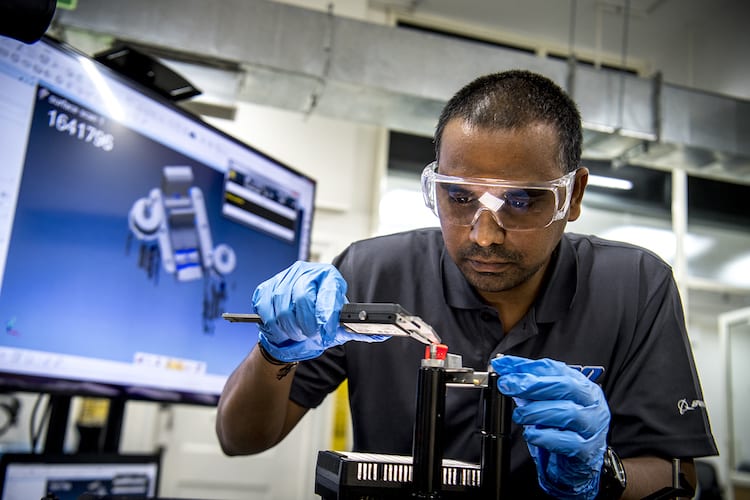
An engineer working on aircraft components at Boeing’s manufacturing facility in Bangalore. Photo: Boeing India
By 2025, India is expected to surpass the U.K. as the world’s third largest market for commercial airline operations. The South Asian nation’s passenger traffic is projected to surge to 278 million annual passengers while also accounting for 19.1 million new aviation jobs according to the International Air Transport Association’s (IATA) latest 20-year global forecast.
Boeing also projects demand for 2,100 new airplanes worth $290 billion in India over the next 20 years.
This type of robust growth potential has attracted major investment from aerospace industry giants to establish new facilities in India.
Airbus for example has a joint commercial and defense aircraft training and engineering center with 5,000 employees in Bangalore. There the company is developing flight management systems, computational fluid dynamics (CFD) and digital simulation and visualization.

Boeing India workers at the Tata Aerospace facility build the AH-64 Apache helicopter. Photo: Boeing India
The French manufacturer is also working with technology startups at its Airbus BizLab in Bengaluru. There, startups are provided with a six-month accelerator program where they’re given access to free office space and a pool of mentors and experts from within Airbus to help their ideas and business plans take flight. Over the last two years, the business accelerator has mentored 16 startups.
One such company, Mumbai-based Airpix, was recently able to secure a joint go-to-market partnership with Airbus Aerial services to provide its customized three dimensional drone data analytics, automated data interpretation, aerial data visualization and measurement solutions in India.
Boeing’s India Engineering & Technology Center (BIETC) is also located in Bangalore and has expanded from just 50 employees in 2015 to 1,500 today. The company also works with 160 different suppliers in India for systems and components featured on 737, 777, 787, P-8, F/A-18 Super Hornet, F-15, KC-46 Tanker, V22, AH-64 Apache and CH-47 Chinook.
HorizonX, the venture investment division launched by Boeing in 2017 to invest in disruptive aviation technology startups, is also helping to foster new innovation for the aviation industry developed by Indian aerospace engineers.
“Launched in partnership with India’s largest startup incubator, T-Hub, the 2018 Boeing HorizonX India Innovation Challenge invited disruptive solutions to tackle complex challenges in the areas of autonomous and unmanned systems, advanced manufacturing, industrial Internet of Things (IOT) and automation, analytics, artificial intelligence and machine learning,” Bala Bharadvaj, managing director of BIETC said.
That challenge lead to the selection of three aerospace startups that Boeing will provide funding around.
The three startups include a company called Merxius, which has developed an extended reality (XR) authoring software for non-coders. Their software is designed to reduce reduce training times in aircraft manufacturing through the use of extended reality training environments. A second company, HuviAir, provides custom unmanned aircraft services and software solutions for surveying and workflow management. The third, ZestIOT is developing airport and airplane IOT technologies designed to optimize ground handling at airports and improve on time performance.
Boeing also has a major new partnership with Hindustan Aeronautics Limited (HAL) and Mahindra Defense Systems (MDS) for manufacturing the F/A-18 Super Hornet in India.
“Boeing’s Make-in-India Super Hornet proposal would bring final test and assembly of Super Hornets to India. A Boeing- Hindustan Aeronautics Limited (HAL)-Mahindra Defence Systems (MDS) partnership will transform India’s aerospace and defense ecosystem by manufacturing F/A-18 Super Hornets in India and developing future technologies jointly,” Bharadvaj said.
This article was originally published in the December/January edition of Avionics. Read the full version of the article in the digital edition here.